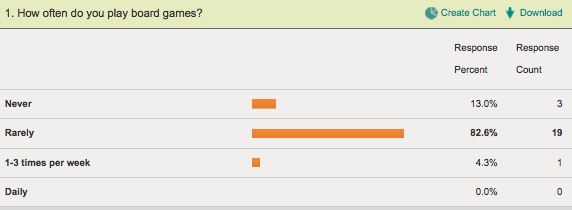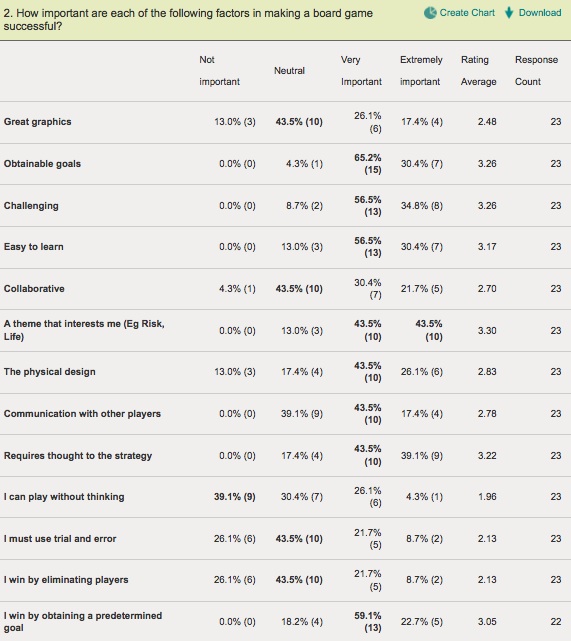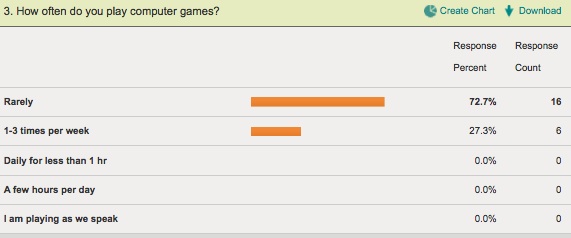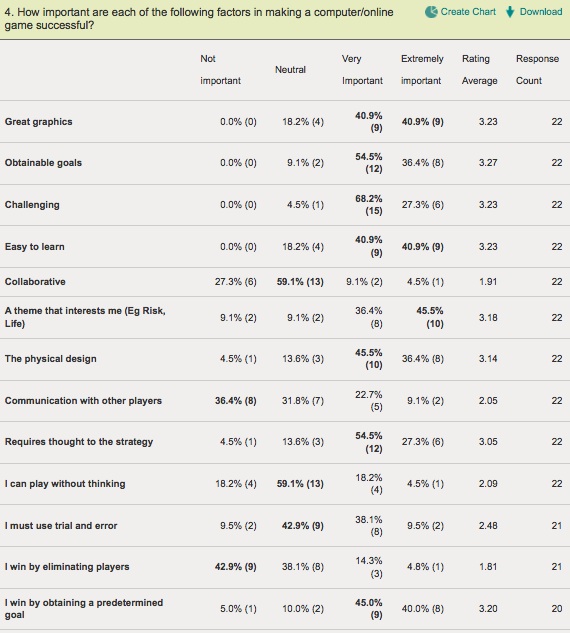Properties of Games-The survey says…….
Results as of June 16th, 11 am PST. (23 responses)
Now that you have seen the results of what we as a cohort think we will take a look at what are considered by some to be the properties which make are required to make a GREAT game whether it be a board game, an online game or an interactive simulation game.
Meaningful Choices
In games you make choices but if only one of them is attractive then you really only have one choice. Meaningful choices are all valid and the choice will be determined by short/long-term goals or may be geared towards thwarting opponents. (Gamers Mind, 2006). But not all choices are created equal. A great choice must be difficult since easy choices are not choices at all. There are many forces at work, pulling you in different directions. Finding the right balance between these forces–one that is correct for the current situation, and your strategy–is what makes the choice great. Great games have great choices! (Gamers Mind 2005). It is the continuous decision making and challenges which gets players hooked.
Tactics
Short term goals, which you try to reach during your turn.
Strategy
The actions you take to accomplish the main goal.
Rich Player Interaction
Everything you do should affect other players in the game whether it be positive or negative. You can create alliances, go after a specific player or resource, bluff…the list is endless.
Presentation
The greatest game in the world would cease to be great if the physical design was unsatisfactory.
Gamification in Education
Combining games and education is not always easy since they often focus on one topic and it can feel forced. The “educational” games not become blockbuster hits but some have been successful in engaging students.
Unsuccessful games
Lure of the Labyrinth
Lure of the Labyrinth is a web-based game made for middle school math students and has the look and feel of an online game complete with avatars, levels and three different underworlds. It has been around since 2009 and still has not captivated its middle school audience. Many pages of information for teachers and students and a trial and error system for success might be one of the reasons. A game does not need to be easy but it should be easy enough for a player to start the game so that the learning can take place.
Successful Games
Where in The World is Carmen Sandiago?
The video game, Where In The World is Carmen Sandiago, has been very successful in integrating history and geography while engaging kids is a strategy to find Carmen Sandiago. Since its beginning in 1985 it has captivated its young audience in which they have a goal of capturing Carmen Sandiago by chasing her all over the world following clues. They move up in rank from rookie, to sleuth and all the way to up to ace detective.It is interesting to look at the change in graphics below from 1985 (first video) and 2006. The first video is very long but a minute or two gives the idea.
Carmen Sandiago: 1985 version (DOS)
Carmen Sandiago: 2006 version
Timez Attack
Timez Attack is another game has many of the qualities of a good game and has had success over the years. It is easy to learn and players move up in rank.
Continue to Activity 2: Voicethread
Authored by Bridget Perry-Gore





Hi Bridget and all group members,
Your blog site is very well organized and rich in content. Great work. I really liked the survey idea because it got me thinking about my individual view of what defines a “good game” and then start looking at these elements as a teacher/educator.
I found the survey clear and to the point and it was interesting to see the results to date. Looking forward to exploring the rest of the topics in more detail.
Thanks,
Leonora
Hi Lenora,
Thank you. It was an interesting topic to work with.
Bridget
I like your group’s idea of using the survey to gain some insight into how often and why we play games. So far, as I would have expected the results show that we rarely play either board games or computer games and this is likely attributed to the demographic/age group of students in this course. If I were to give this survey to my students I know the results would show that they play games on a daily basis on their phones, tablets and computers but rarely play board games. I am not a gamer myself but I can see the value of creating educational games that engage students in the learning process. I have used All the Right Type with my grade 8 students to help them improve their touch typing skills. Although the game is pretty basic the students enjoy it a lot more than using typing sheets and have fun competing against their classmates for the highest WPM (Words Per Minute).
Greg
Hi Greg,
I agree with you about the demographics/age group. I find that I used to play board games when my kids were younger. When they all come home for a visit we have a resurgence……each choosing their favourite.
I am not a great typist but I used one of the online games in an effort to learn and I thought it was very effective. Recently, I was helping out at a community centre where they teach computer skills to Seniors…..who also love the game aspect.
Bridget
The survey was an excellent way to get me thinking about what features attract me to a good game and how those same features need to be incorporated into an educational game. I am curious, however, why you never gave the “Never” option for the computer games while you did for the board games.
The 1985 version of “Where in the World is Carmen Sandiago?” sure brought back memories, especially the background music. I can attest to the fact that I learned a lot of geography in playing this game. Simple as it was compared to today’s games with respect to graphics and speed, it sure was effective. It had the necessary hook and continued motivation through competition that kept me going.
Tim
And all along I thought that gaming was playing poker on-line. So far I’m learning a lot from this group’s activities. I enjoyed looking at the examples of different educational games, especially “Carmen Sandiago”. It’s amazing how the graphics from 1985 are different from 2006. Actually, the 1985 version reminded me of the text in the first video game I ever played which was called “King’s Quest”. I don’t think that I ever solved that game because I always arrived at the same spot where I was always stumped:( The 2006 graphics reminded me of the game “Syberia” that my daughter loved.
Thanks for your efforts group and I’m looking forward to learning more about gaming this week.
Donna
From the survey, I reflected on how games changed for me. I recall video games that I played on the Super Nintendo as a child, compared to what I enjoy now, there is a shift in stress factor. I don’t think graphic was as big of a concern. The amount of time required to advance in levels is also a lot longer than most games I play now (I enjoy playing video games that kids are into, so I have a greater understanding of what they are exposed to and why they might be addicted to the gaming world… ). Even games such as the Professor Layton series tend to reward faster than E.V.O. With that, I wonder if that is also a part of changing of social norms. I feel that it is becoming more and more of a fast-food world now with knowledge and ideas… or perhaps I am just growing old.
Thank you for putting together this wonderfun presentation!
Sherman
Hi Sherman,
I agree with what you say about the shift in stress factor. The original “pong” caused enough stress for me. The time invested in learning the early games such as Pacman and the Nintendo series was minimal and the goal was obvious. There were few decisions to make and the outcomes were usually predictable. For example if you go to fast you will fly off the race track. These are easy to relate to.
The intricate games of today require many hours of training using trial and error, the web, friends….whatever it takes.
I had a great discussion with a person I met who works in the game design industry. His job is to play the games and give feedback and suggestions for the programmers. He says how some of them are so difficult to figure out that even he looses interest. There is a balance in there somewhere which the industry strives to obtain.
Another interesting piece of information that he offered was that the purchased games should take about 40 hours of play to complete. I thought this was an interesting marketing idea. And why 40? There must be something to this magic number not unlike Malcolm Gladwell’s 10 000 hour rule.
I am glad that you enjoyed the journey this week,
Bridget
Thank you for your research on gaming and your samples of games. I found your survey very interesting, though I found the gap between neutral and very important to be too large. I was also interested that people want to play games without thinking, because my love of games has a great deal to do with the thought involved. Maybe it’s kind of like knitting: there’s thought involved to choose the pattern and wool, and to make sure the result will suit the desired outcomes, but there is also a great deal of time spent mindlessly making stitches. If gaming is for education, we need to want to think while we’re gaming! But maybe there is a place for mindless participation in the process. Great idea to give us the survey.
Hi Chelsea,
Do you think that whether people want to play without thinking or enjoy playing because they are thinking might depend on why they are playing? If I play to escape, I might choose Spider Solitaire or Angry Birds (some thinking, but more relaxing) but if I am playing because I am bored and want to do something, I choose a more challenging game. I found that question a hard one to answer because my answer really varies depending on why I am playing the game.
Janet
Hi Janet and Chelsea,
I agree that it depends on what you want to achieve from the game I chose the same for “minless” as I did for “challenging”.
Denise
Hi Janet,
You have a good point about game choice. Angry Birds only comes out on holiday when I need something uncomplicated.
Bridget
Hi Chelsea,
re: “gap between neutral and very important to be too large”
Thank you for this comment. I actually found it more difficult than expected to create the survey. The technology was fine but the selection of words and answer choices was not always obvious. I get annoyed when filling out surveys where the answer I would like to give does not fit and it is good to be on the other side of the fence.
Something to work on…
Bridget
Thanks for an informative and interesting presentation on gaming. The video clip about Carmen Sandiago brought back memories of hours and hours flying around the world with my kids while they played.
I think, from experience with my own children and those at the school, that board games are still interesting and engaging for children. Every time my own 3 come home, one game comes out and we spend the night playing together. Schools now hold game days or game nights to draw parents and kids into playing board and card games together in a social setting. I think the survey results would be very different with another demographic.
Helen
Hi All
Nice presentation! You followed a neat method in reflecting the main points of the theme and it was a good choice to utilize a blog service.
The idea of applying the concept of gamification is undoubtedly new in the field of education. It has its supporters and also its opponents. But there is still much debate on it from many educational sources. From my experience I can say that its opponents are more than supporters. And the reason for that is the incomplete understanding of ET and how that can affect the shape of education. In addition to that , there are a lot of other factors that affect people’s way of thinking about “gamificating” education. The concept is still new relatively speaking. It can be misused if it doesn’t follow a proper method. I just feel it is hard ( or will be hard) to put special criteria to be followed when it comes to “gamificating” some parts of education. I until this happens there will be a lot of debate about the whole thing.
Hussain
I hear they are working on a gmaing for education course through the MET program. unfortunately most of us will be finished before the course is up and running. I do plan to take a similar course through the University of Alberta sometime next year. I hope it teaches me how to really engage students through games, especially online gaming.
As for gaming for education, I see it as a great breakthrough for teachers and learners. kids love to play games and they generally enjoy learning so if those two worlds can be intertwined all the better. I see it as one the emerging markets to watch.
Dennis
A game in MET – makes me want to take longer to finish!
I was reflecting on games for higher education not just K12 and revisited the two Horizon reports. One of the articles 5 Lessons professors can learn from Games had an interesting take on the topic – not just using games (when appropriate) but also a reminder that the educational design elements games use are important to integrate in teaching and learning.
http://chronicle.com/article/5-Lessons-Professors-Can-Learn/63708/
Denise
Hi Dennis,
I think that Gamifiaction will find its way into classrooms soon enough. It might be a tough sell to the traditional setting and will take a few risk takers (like many MET students) to get it going.
The course would probably be great!
Bridget
I wonder how the K-7 and 8-12 responses would compare to adult responses. I think it would be worthwhile to gather K-7 and 8-12 responses. I’m quite certain that there will be some differences between our responses. From an educator’s point-of-view, it could help our instructional design by helping us select the educational games that engage students.
Hello Team,
Your survey and the subsequent breakdown of responses really gave me food for thought. While I rarely if ever consider myself a computer gamer, I never really considered the link between board game design and computer game design. While I don’t often play board games, I do enjoy them, while I tend to dislike computer games (unless they are mindless puzzles or very compelling trivia on a topic in which I alread have an avid interest). Part of the difficulty for me comes from the interface of video games versus physical board games, which is where many of the education games I’ve tried out failed to ‘hook’ me.
Hello Team,
I really enjoyed your site as a whole and found it very engaging – great mix of activities! This was highly relevant to me as my students just finished creating Board Games of their own. The kids were more concerned about how the game looked than they were about how the game was played, which I find interesting when compared to your survey results. When they finished creating their games and played them, however, it became clear that they had packed a lot of info and ideas into those games – they taught each other while they were playing games…it was great!
Is it enough for a game to be entertaining? Does it have to disguise that learning is occurring or can we combine the two – can they be aware that they are learner, or will they abandon it as ‘too educational’? Either way, I think it’s interesting!
Thanks,
-Meggan